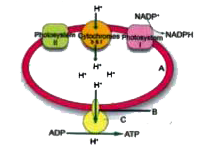During ATP synthesis , electrons pass through
CO2
O2
H2O
Cytochromes
The correct Answer is:D
Step-by-Step Solution:
1. Understanding ATP Synthesis: ATP synthesis occurs through two main processes: oxidative phosphorylation and photophosphorylation. Oxidative phosphorylation occurs during aerobic respiration in animals, while photophosphorylation occurs in plants using light energy.
2. Role of Proton Gradient: Both processes require a proton gradient (also known as an electrochemical gradient) to synthesize ATP. This gradient is essential for the phosphorylation of ADP to ATP.
3. Electron Transport Chain: During ATP synthesis, electrons are generated from various substrates and pass through a series of protein complexes. These complexes are crucial for establishing the proton gradient.
4. Identifying the Correct Pathway: The question asks where the electrons pass through during ATP synthesis. The options provided are carbon dioxide, oxygen, water, and cytochrome.
5. Analyzing the Options:
- Carbon Dioxide: Incorrect, as it is a product in oxidative phosphorylation and a substrate in photophosphorylation, but not a pathway for electrons.
- Oxygen: Incorrect, as it is a product in oxidative phosphorylation and a substrate in photophosphorylation, but not a pathway for electrons.
- Water: Incorrect, as it is utilized in photophosphorylation to generate electrons and is formed in oxidative phosphorylation, but not a pathway for electrons.
- Cytochrome: Correct, as cytochromes are protein complexes through which electrons pass during both oxidative phosphorylation and photophosphorylation.
6. Conclusion: The correct answer is cytochrome, as it is the pathway through which electrons pass during ATP synthesis.
Final Answer: Cytochrome
---
- Carbon Dioxide: Incorrect, as it is a product in oxidative phosphorylation and a substrate in photophosphorylation, but not a pathway for electrons.
- Oxygen: Incorrect, as it is a product in oxidative phosphorylation and a substrate in photophosphorylation, but not a pathway for electrons.
- Water: Incorrect, as it is utilized in photophosphorylation to generate electrons and is formed in oxidative phosphorylation, but not a pathway for electrons.
- Cytochrome: Correct, as cytochromes are protein complexes through which electrons pass during both oxidative phosphorylation and photophosphorylation.
Topper's Solved these Questions
- PHOTOSYNTHESIS IN HIGHER PLANTS BOOK - AAKASH SERIESCHAPTER - PHOTOSYNTHESIS IN HIGHER PLANTS EXERCISE - Exercise - II
33 Videos
- PHOTOSYNTHESIS IN HIGHER PLANTS BOOK - AAKASH SERIESCHAPTER - PHOTOSYNTHESIS IN HIGHER PLANTS EXERCISE - Exercise - III
27 Videos
- ORGANISMS AND POPULATIONSBOOK - AAKASH SERIESCHAPTER - ORGANISMS AND POPULATIONSEXERCISE - EXERCISE-III (PREVIOUS AIPMT/NEET QUESTIONS)
35 Videos
- PLANT GROWTH AND DEVELOPMENT BOOK - AAKASH SERIESCHAPTER - PLANT GROWTH AND DEVELOPMENT EXERCISE - EXERCISE -III (PREVIOUS AIPMT/NEET QUESTIONS)
27 Videos
Similar Questions
Knowledge Check
Read the given statements and select the correct option.
Statement 1: In photosyntheis, during ATP synthesis, protons accumulate in the lumen of thylakoid.
Statement 2: In respiration, during ATP synthesis protons accumulate in the intermembranal space of mitochondria.ABoth statement 1 and 2 are correct.BStatement 1 is correct but statement 2 is incorrect.CStatement 1 is incorrect but statement 2 is correctDBoth statements 1 and 2 are incorrect.During chemiosomotic synthesis of ATP, protons diffuse through CF0 channels that activates ATPase enzyme As a result, one molecule of ATP is formed when___passes thorugh ATPase.
A4H+BH+C2H+D6H+
ATP synthesis in cell requires
View SolutionWhen an electronl beam passes through and electric field they gain kinetic energy. If the same electron beam passes through a magnetic field then their
View SolutionIdentify the parts marked as A, B and C in the given figure showing ATP synthesis through chemiosmosis

View SolutionWhich theory explains ATP synthesis in chloroplasts and mitochondira ?
View SolutionATP synthesis during light reaction is
View SolutionWhich of these inhibits ATP synthesis in mitochondria by inhibiting electron transport through complex IV
View Solution
